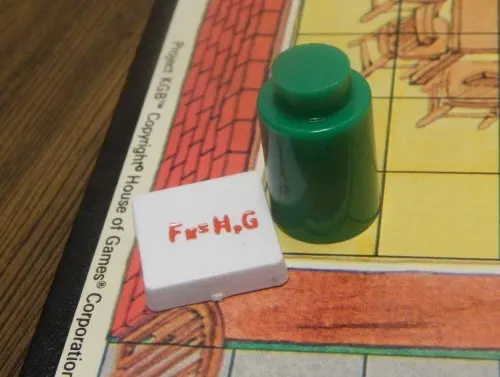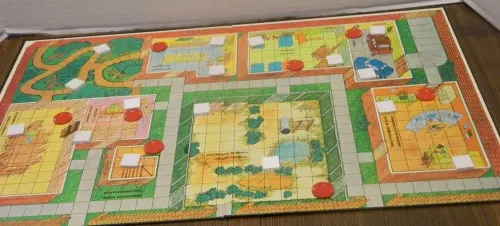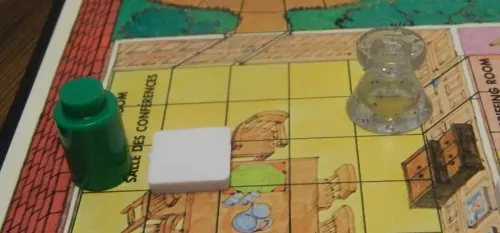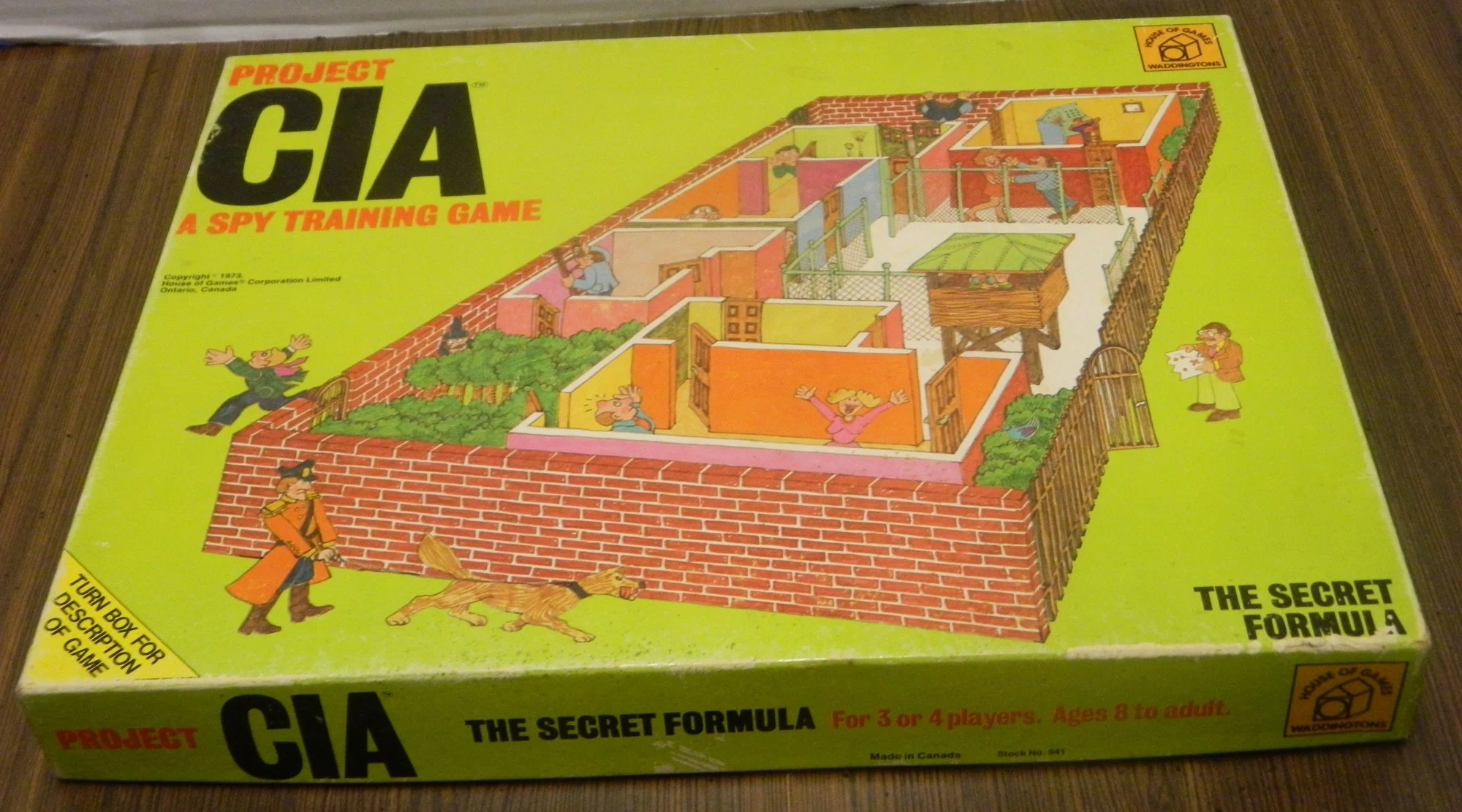How to Play
Each player chooses a token. The players take 17 of the envelopes making sure to include the briefcase with the secret formula. The envelopes are shuffled (making sure that all of them are face down) and one briefcase is placed on each “x” mark on the gameboard. All of the players roll the two dice. Whoever rolls the highest number gets to decide which corner of the map that they would like their playing piece to start. In a clockwise fashion the rest of the players get to pick where they would like to start (no two players can start from the same spot).
A player’s turn begins with them rolling both dice. A player must move the entire count of their roll. Players must move on squares outlined in black and may not move diagonally. To enter rooms a player must move through the door space. When a player lands on an envelope or moves through one, they take possession of it. The player can look at the other side of the envelope to see if it has the secret formula. If there is red text on the other side, the secret formula has been found. The player then needs to try and reach one of the exits (corners). They don’t want to be too obvious about it though since the other players will then try to catch them and take it from them.

While moving if one player either lands on or moves through a space occupied by another agent, they knock out the other agent. The knocked out agent loses all of their envelopes to the player that knocked them out and they lose their next turn.
In addition to having to deal with the other players, you must deal with the guard. Generally the guard moves in a predetermined route. At the end of a round (before the first player’s turn) the guard will move to the next location on its’ route. The guard follows this route:
- Tower
- Briefing Room
- Conference Room
- Laboratory
- Residence
- Garage
- Communications Building
- Training Ground
- Back to the Tower

The guard can also be moved by an alarm. If any player rolls doubles while in a room, the guard immediately enters the room that the player was in when they rolled doubles.
When a player is in the same room as the guard they roll both dice in order to try and escape the room. A player may not move through the space occupied by the guard while trying to escape. If the player(s) roll a number high enough to escape the room, the players move out of the room and nothing else happens. If the player is unable to escape the room, they are captured by the guard. When captured the player needs to drop all of their envelopes onto the space where they were captured. Their pawn is removed from the board and their next turn is skipped. After the skipped turn the player can enter through any of the gates (corners of the board).

Some additional rules regarding movement and the guard:
- Player pieces on a doorway space are not considered in a room. If a guard enters a room where a pawn is in a doorway, that player does not have to escape the room.
- If your piece is on the space where a guard ends up moving to, you are automatically captured.
- Guards move directly from room to room. If a guard would have moved through the area where a pawn is located, that pawn is not captured.
- If you enter a building that the guard currently occupies, you are automatically captured.
- Rolling the dice to escape the guard does not count as a player’s normal roll.
- A player that is knocked out cannot be immediately knocked out again. If the knocked out player has already skipped their turn though, they can be knocked out again.
- If you are knocked out and a guard enters the room, you are automatically captured. You do not miss an additional turn though.
Whichever player is able to escape with the secret formula is declared the winner.
My Thoughts
In 1973 the Canadian company House of Games Waddingtons created the game Project CIA A Spy Training Game. I think it is kind of weird that a Canadian company made a game about a United States spy agency.
Project CIA is a simple roll and move game with the added mechanic of having to find a secret formula. If you have seen any of my previous reviews of roll and move games you probably already know that I am not a huge fan of the genre. The main reason why I don’t like the genre is that they are usually entirely based on luck and just aren’t that interesting. Project CIA is actually better than a lot of roll and move games but it is still not that good of game.
The one thing that could have made the game good was the addition of the secret envelopes. The concept of all of the players searching for the secret formula at the same time could have been interesting. Players could have played mind games with one another either making players think they have the formula when they don’t or making them think they didn’t have it when they did. The game’s instructions keep bringing up that when you find the secret formula you need to hide that fact. They suggest that you may want to pretend that you are still searching for the formula by picking up additional envelopes. This actually sounds quite interesting and it could have made a good game.
Unfortunately this tactic is pretty pointless since it is hard to hide that you got the secret formula and it usually isn’t even necessary. If you steal the formula from another player, they will know you have it and based on their actions they will likely tip off all of the other players that you have the formula. Since everyone will know that you have the formula, you really can’t waste time trying to deceive the other players since the player you knocked out will start chasing you down.
The biggest reason the espionage angle doesn’t work is that in most cases you don’t even need to be sneaky about it. In most cases you have a head start over the other players so if they find out it doesn’t matter since they won’t be able to capture you anyway. A player could actually end up finding the secret formula in the folder closest to their starting space. If this occurs the player will automatically win since there is no way the other players will catch the player since the players are so spaced out to start the game.
This is actually why I think the gameboard should have been more smaller. With there being so many spaces and the folders being pretty far away from one another, the players tend to not be by one another very often. Whenever someone finds the secret formula they are probably best off just running towards the closest exit since none of the other players are likely to catch them before they reach an exit. If the gameboard was more condensed I think the game would have been more strategic. You might have actually had to try and deceive the other players before trying to escape since they would be close enough to actually catch you if you tried to escape.
This race to the exit showcases the main issue with the game. Your success in the game is dependent on how close the secret formula is to your starting location and how well you roll the dice. If you are the first person to get the secret formula you are likely to win since you will have a good head start to one of the exits. They will only catch you if they roll considerably better than you. If they do catch you though, they are pretty much guaranteed to win. The escaping player will have most likely taken the secret formula close to one of the exits. Unless there is another close player, the player who knocked out the other agent will most likely easily get the formula back to one of the exits since they will have a turn head start on the player they knocked out.
The guard mechanic in the game was another wasted opportunity in my opinion. The idea of the guard going around the board was interesting. With the guard having a predetermined route, the guard could get in the way but you also had a way to plan what you wanted to do since you knew where the guard was headed next. Two things ruined the guard in my opinion. First the alarms seemed to go off all the time. It was probably just a coincidence but my group kept rolling doubles so the guard was constantly moving to rooms where the alarm was set off. This happened so often that the guard never even came close to completing a full rotation around the board. The second problem is that it is way too easy to avoid the guard. Since most of the rooms don’t have a lot of spaces, it is pretty easy to roll a high enough number to escape any room. In the game I played there were plenty of guard encounters and only once was the player unable to escape.
One interesting fact about Project CIA is that it was originally designed with an companion game already in mind. Project KGB: The Double Agent is another game created to go with Project CIA. Project CIA even has spaces on the gameboard where the Project KGB board is supposed to connect to. I don’t have the KGB version of the game but it actually sounds more interesting than the CIA version. The KGB version can be played by itself and it appears that the goal is to figure out which of the other players is the undercover agent while the KGB agent tries to complete a secret mission. When the two games are combined the gameplay from both games are added together. Even though I didn’t particularly like Project CIA, I kind of wish I had Project KGB in order to give the expanded version of the game a try.
As far as components, I thought they could have been better. The playing pieces are just generic movers. The folders are okay but they kind of feel cheaply made. The gameboard could have used some work. As I mentioned before I think the gameboard should have been more condensed. The artwork on the gameboard serves its’ purpose but is nothing special. The gameboard could have done a better job making the doors more visible. In several areas it was hard to see what spot a pawn needed to be on in order to enter/exit a door.
Final Verdict
Project CIA is a roll and move game. Being a roll and move game, luck has a big impact on the game. The game had the potential to be a pretty good roll and move game but unfortunately the unique gameplay mechanics fail to add anything new to the game. With these gameplay mechanics failing, the winner of the game generally comes down to who ends up starting closest to the location of the secret formula. Even with all of its’ issues, Project CIA is actually better than most roll and move games.
If you don’t like roll and move games, you won’t like Project CIA. If you really like roll and move games though you may want to give Project CIA a chance since it tries to add some new ideas to the roll and move genre.

